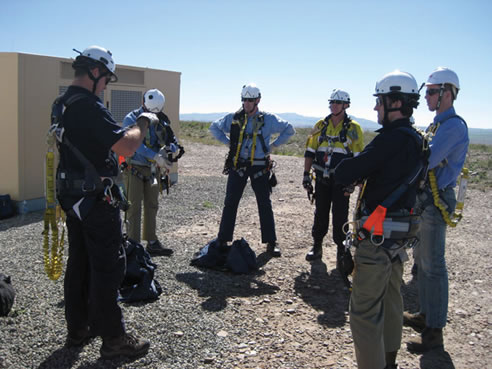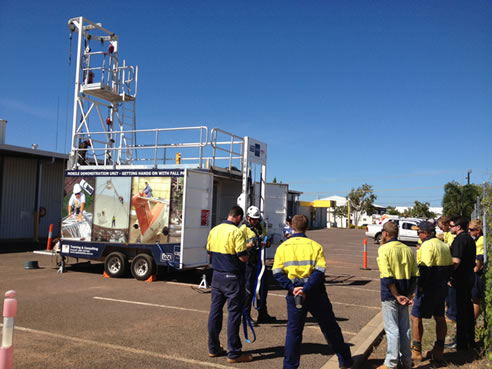Fall Protection Equipment and Training from 3M Safety

Fall Protection: I have my gear. Now what?
By Michael Biddle
Let's face it - accidental falls on the job happen. Even workers with extensive experience working at heights can lose their balance, trip or misstep. The danger of falling at height is real, and can bring devastating consequences.
In Australia over the eight year period between 1st July 2003 to 30th June 2011, 232 workers were killed following a fall from height, which represents 11% of all fatalities recorded in the period. The leading cause of worker fatalities on construction sites is falls, accounting for 37% off all deaths. *
Falls are strongly represented in other industries as well - specifically agriculture, (including forestry & fishing), transport (postal & warehousing) and manufacturing. Regardless of industry, the impact on the health of workers sustaining falls is significant. In 2011 alone, 7730 claims for serious injury were lodged due to a fall from height, meaning 21 employees per day lodged a claim for an injury that required more than one week off work. Additionally, a typical fall-related claim in 2011 involved 6.2 weeks off work, which is considerably longer than the 4.4 weeks for all serious injury claims. *
Fatal falls are often the result of a failure to follow workplace safety procedures, a lack of proper safety gear to perform the job, or the misunderstanding or misuse of equipment. The reality is that the effectiveness of fall prevention and protection equipment, no matter how durable or reliable, is compromised when workers don't use products correctly.
When do I use Fall Protection?
Where buildings or structures are in place and maintenance activities required to be undertaken, safe means or systems of access may already be available. For example, the use of parapet walls on commercial buildings, combined with walkways, guardrails complying with AS1657. Where there are no alternative practical means of access, fall protection equipment may be required.
To ensure the safety of their at-height teams, this is where companies need to get serious about fall protection equipment and learn what systems and components are ideal for each job. Safety gear is not one-size-fits-all, nor is it one-product fits-all-applications. Different scenarios require different equipment. Provide the best job-specific equipment and ensure your workers are knowledgeable about the products they use and their safety will be maintained.
Choosing your equipment
Typically we want to avoid the circumstance where a person has purchased gear for a job, without specific applications in mind. When it comes to fall protection equipment, there are four functional categories of you should be familiar with:
1. Fall arrest
This is where if any risk exists that a worker may fall from an elevated position and therefore a fall arrest system is required.
Fall arrest systems only come into service when an actual fall occurs; in other words, the device is designed to arrest a fall in progress. A typical fall arrest system is composed of a full-body harness with a shock-absorbing lanyard or retractable lifeline, an anchor point, and a means of rescue.
2. Work Positioning / Restraint Technique
A positioning system holds the worker in place while keeping his or her hands free to work whereas a restraint technique system allows a worker to egress towards an edge but not fall. It's important to remember that under AS/NZS1891.4, while a positioning system is not specifically designed to arrest a fall, all of the equipment used to create the work position must be rated for fall arrest. This was added to the Standard in 2007 due to the possibility that a person utilizing work positioning equipment may have a change in their environment that moves their circumstance from work positioning to fall arrest and therefore need therefore to protect the person following a free fall. Such a circumstance might be the collapse of a balcony, a fall through a skylight when traversing a roof or other similar event.
3. Suspension
Suspension equipment lowers and supports the worker while providing a hands-free work environment. A suspension system's components are also not required to arrest a free fall, so it's crucial to use a backup fall arrest system in conjunction with a suspension system in the event the circumstances change.
4. Rescue/Retrieval
This component of a fall protection system should be in every Safe Work Method Statement, however it is often forgotten or ignored. In the event of a fall, retrieval equipment is needed to rescue or remove a worker and bring them to a safe level. This could be either a self-rescue or a peer-rescue, depending on the particular situation. Such devices include tripods, davit arms, winches and comprehensive pre-engineered rescue systems. Choosing the right descent and rescue equipment depends on the jobsite and the task being performed.
Equipping workers with durable and reliable job-specific equipment is a great step toward improved safety. However, the right fall protection equipment for the right application, even if it's paired with a written fall protection plan, still isn't enough to keep workers safe on the job. Even the most comprehensive plan will fail if workers are not adequately trained to execute the program and use the equipment properly.

Training: A Vital Tool to a Safer Workplace
Formal training is crucial for any person who performs work at height-no exceptions. Without such training, workers may not fully comprehend that the severe consequences of a fall, including serious injury or death, can happen.
Until workers actually see that fall protection equipment can be comfortable and easy to use, they may avoid donning it altogether. Others might be embarrassed to ask about the proper way to use the equipment and use it incorrectly as a result, which will ultimately decrease the effectiveness, comfort level and usability of the equipment. Therefore, it's important to instill the value of fall protection training within your workforce.
All employers should provide training programs tailored to their specific job tasks and environment. Training sessions can cover a variety of pertinent topics, such as:
- Identifying, eliminating and controlling potential fall hazards
- Inspecting, using and maintaining fall protection equipment on a regular basis
- Executing the tactics within a fall protection plan
- Compliance with applicable industry standards
A detailed overview of the recommended 'levels' of training required from a worker through to a site manager is detailed in AS/NZS1891.4, section 2.2.11 and also Appendix E.
Employer obligations
The statutory obligation to provide a safe work environment for all workers and visitors to a site rests with the site owner. Given that construction sites are typically littered with many hazards including falls, it is critical that all relevant state regulations, Codes of Practice for safe work at height and the Standard AS/NZS1891.4 are closely observed. All these guidelines specify the involvement of a competent person to undertake tasks on a worksite. AS/NZS1891.4 defines a competent person as someone with "the skills education and experience to perform a specified task." It is up to the employer to ensure that only those people performing working-at-height activities are competent to do so.
How do I determine if someone is competent?
Regrettably there is currently no licensing or defined requirements by regulators to determine what a competent person actually is or 'looks like'. It is therefore contingent on the employer to be able to assess a person's competence to complete a set of tasks. One way they can achieve this is to obtain from the employee certificates of competence from a reputable training organisation specific to work-at-height activities, along with a resume of their various work activities.
The employer may alternatively take the decision to provide competency based training regardless of prior skills, to ensure they have a standard level of skills across all employees undertaking work.
Who should deliver training?
Fall protection training is best delivered by training organisations that specialize in vocational training and assessment. In Australia, Registered Training Organisations (RTOs) are independently assessed by the Australian Skills and Quality Authority (ASQA) for their ability to deliver competency based training against a strict criteria. TAFE colleges and private training organisations are examples of RTOs. They should be able to provide you with a registration number to validate their status as a current provider. Another method to validate their competence is to identify their details on the www.training.gov.au website, which will also allow you to verify the nationally recognized competencies they are registered to deliver.
Types of Training
Since workers typically learn the most by watching first then doing, it is best to conduct a fall protection training program with an equal amount of classroom and hands-on instruction. The key with any training program is to provide learning that approximates actual work conditions so the workers can easily apply what they've learned to real situations.
Classroom training
Most classes combine lecture style training, including slides and video, with group discussions to apply theory to practical applications. Training manuals should be provided for workers to reference both during and following the course. Important topics to address include fall energy and how to accurately calculate fall clearance.
Equipment demonstrations and tutorial videos can also be provided during classroom training. From here, workers should be prepared to move on to practical applications where they will experience firsthand how to properly use equipment and execute the fall protection plan.
Hands-on training
Hands-on training allows workers to learn by doing and gives them the opportunity to be corrected in a controlled environment. When talking about a harness, for example, there is no substitute for putting it on and having it adjusted properly, connecting to an anchor, experiencing how it feels and seeing firsthand what needs to be inspected before use. Workers can also conduct mock trials of the fall and rescue procedures to become familiar and comfortable with the tactics in their plan. Hands-on training is by far the most effective and most desirable type of fall protection training.
Hands-on learning experience can be offered either on or off the worksite. Courses at an off-site facility provide controlled environments uniquely designed to offer practical experience. On-site courses, on the other hand, apply professional training to your specific daily work activities. By training in and around the workers' normal environment, you can ensure that the issues discussed are immediately applicable to your employees.
Assessments
Training courses should be competency-based, with each course having a specific and relevant unit of competency as indicated by the learning objectives and lesson plan. With these types of programs, writing assessments and/or hands-on exercises are to be completed by workers to show knowledge retention of the presented information and the ability to apply it in a work-like environment.
The bottom line
Give your workers the confidence they need to conduct their work safely with the right equipment and with the knowledge to help their co-workers in the event of a fall. Equipping your team with the right fall protection equipment is a vital step toward a safer jobsite. However, none of it will make a difference unless each and every one of your workers knows how to use the equipment and, simultaneously, understands the consequences of not using it.
Invest the time and effort to ensure your employees not only have the right gear for a given job, but are also using it correctly. Nothing is more paramount than a safe, application-appropriate fall protection system for your workforce.
About the Author
Michael Biddle is Managing Director for 3M Safety, Australian and New Zealand and the current Chair of the Working at Heights Association (WAHA).
* Source: Work related injuries and fatalities involving a fall from height, Australia, October 2013, published by Safe Work Australia.
|




 Fall Arrest Anchorage Connectors from 3M
Fall Arrest Anchorage Connectors from 3M Commercial & Industrial Fall Protection
Commercial & Industrial Fall Protection Personal Protective Equipment Trade-Up
Personal Protective Equipment Trade-Up Safety Gear and Accessories Sydney from
Safety Gear and Accessories Sydney from Worker Health and Safety Video | 3M
Worker Health and Safety Video | 3M Truss Mounted Roof Anchor | 3M Safety
Truss Mounted Roof Anchor | 3M Safety Full Body Harness Range | 3M Safety
Full Body Harness Range | 3M Safety Portable Roof Anchor by DBI-SALA | 3M
Portable Roof Anchor by DBI-SALA | 3M 5-Piece Hoist System for Confined Space
5-Piece Hoist System for Confined Space ExoFit STRATA™ Harness Video | 3M
ExoFit STRATA™ Harness Video | 3M Full Body Safety Harness ExoFit STRATA |
Full Body Safety Harness ExoFit STRATA | Mechanical Prusik Rope-Mate™ | 3M
Mechanical Prusik Rope-Mate™ | 3M Comfort Harnesses for Fall Protection |
Comfort Harnesses for Fall Protection | Personal Self Retracting Lifelines | 3M
Personal Self Retracting Lifelines | 3M Fall Protection for Tools Video | 3M
Fall Protection for Tools Video | 3M Extended Length Self Retractable
Extended Length Self Retractable Engineered Mobile Access Systems | 3M
Engineered Mobile Access Systems | 3M Minimising Risks with Fall Prevention
Minimising Risks with Fall Prevention Double Stop Descenders | 3M Safety
Double Stop Descenders | 3M Safety Sealed Self Retrating Lifelines
Sealed Self Retrating Lifelines
